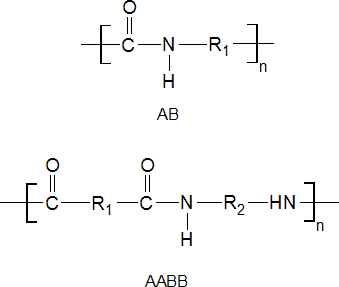Nylon is a synthetic polymer belonging to the polyamide group. It is a manufactured fiber which is formed by repeating units with amide bonds between them. The substances that make up nylon are long-chain synthetic polyamides that have amide groups (-CONH-) as an integral part of the polymer chain. There are several different versions of Nylons, with nylon 6,6 being one of the best known.
The regularity of the amide bonds along the chain determines two classes of polyamides:

Distribution of radicals in the chains
Type AB, which have all amide bonds in the same orientation along the chain, and type AABB, where the amide bonds alternate in orientation along the chain. Both R1 and R2 can be aliphatic, aromatic, or both radicals. Properties vary considerably when they have more than 15% of aliphatic radicals.
Nomenclature
The nomenclature of polyamides varies according to the source, between systematic, semi-systematic and common name. In North America, the common practice is to call the AB type or the AABB type, as nylon X or nylon X,X respectively, where X is the number of carbons in the monomer chain. In the AABB type, the number of carbons in the diamine is named first. In Europe, they are usually called polyamide or its abbreviation PA. The IUPAC accepts the abbreviated form of polyamide as a name. The common name is based on naming each of the monomers. But all these are falling into disuse in favor of the systematic nomenclature that is based on naming them as derivatives of the divalent carbon chains of substituted nitrogens (imino). For example, nylon 6,6 will be called poly(imino (1,6 dioxo-hexanediyl) imino hexanediyl.

History of Nylon
Nylon was the first fiber produced entirely from synthetic polymer and was first characterized in 1899. In 1929, this study was renewed by Carothers at the Du Pont de Neumors Company. The first patent was applied for in 1931 and was published in 1936. In July 1935, nylon 6,6 was chosen by Dupont to be introduced to the market. This was followed by a patent application which was published in 1937. The main polyamides illustrated in these first two patents were NYLON-6, NYLON-7, NYLON-8, NYLON-9, NYLON-11 and NYLON-17. The first patent application for NYLON-6,6 was published in 1938.
Du Pont began experimental production of nylon in 1938 and the first commercial plant began production in 1939 in Seaford, Delaware (USA). The first nylon stockings were introduced in 1940 and were an immediate commercial success. In the USA a second Du Pont plant began production in 1941, a third in 1947, a fourth in 1954, and a fifth in 1967 using an advanced spinning process. Commercial production of NYLON-6 in the USA began with the large-scale availability of caprolactam, first produced in 1955 by the Allied Chemical Corporation. Since then production of polyamide fibers has expanded widely around the world.
The Second World War helped to incorporate nylon 6,6 into clothing, bumpers and tires with an indescribable impact.